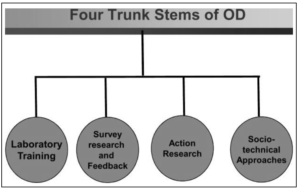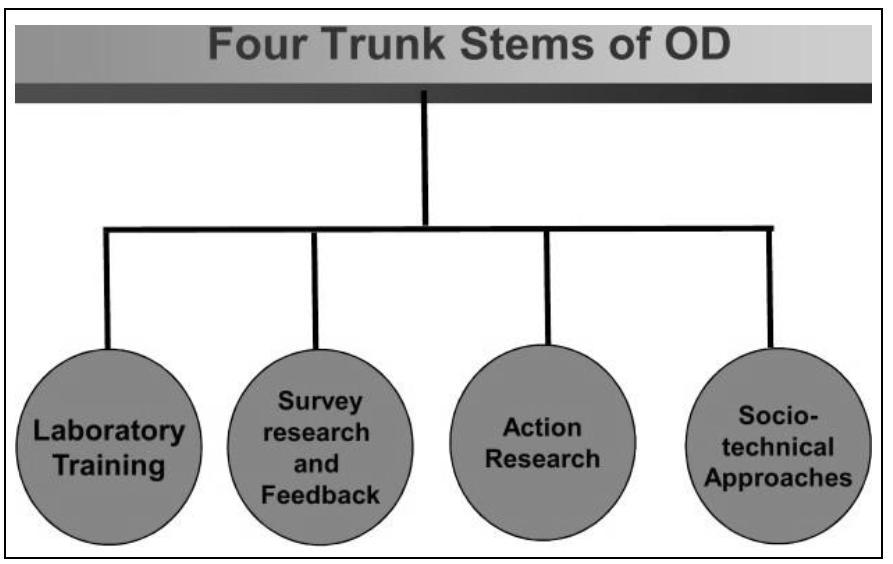- Organisational Development has evolved over the past 60 years from the applications of behavioural science knowledge and techniques to solving organisational problems. It started in the 1940s at MIT and is developed by an applied social scientist such as Kurt Lewin. It is influenced by Carl Rogers & Abraham Maslow.
- During the period around World War II, Lewin experimented with a collaborative change process based on a three-dimensional process of planning, performing and result-measurement. This experiment was the basis of the action research theory. Lewin further participated in the beginning of laboratory awareness training or T-Groups. Later, after his death, his associates developed a survey-research method at the University of Michigan.
- The term organisational development is widely attributed to Robert Blake, Jane Mouton & Herbert Shephard.
Four Trunk Stems of Organizational Development:
- Systematic organisation development activities are studied in an analogy of the mangrove tree, have at least four important trunk stems. One trunk stem consists of innovations in applying laboratory training insights to complex organizations. A second major stem is survey research and feedback methodology. Both stems are intertwined with a third, the emergence of action research. The fourth stem is the emergence of the (Tavistock) socio-technical and socio-clinical approaches. The key actors in these stems interact with each other and are influenced by experiences and concepts from many fields.

Laboratory Training Stem:
- Laboratory training, essentially unstructured small-group situations in which participants learn from their own actions and the group’s evolving dynamics. It began to develop about 1946 from various experiments in using discussion groups to achieve changes in behaviour in back-home situations.
- The major contributions to this concept were from behavioural scientists Kurt Lewin followed by experts Robert Tannenbaum, Chris Argyris, Douglas Mc Gregor, Herbert Shepard, Robert Blake, Jane Mouton and Richard Beckhard.
Survey Research and Feedback Stem:
- It is the second major stem in the history of Organisation development. It involves a specialised form of organisation research. It revolves around the techniques and approach developed over a period of years by staff members at the Survey Research Center (SRC) of the University of Michigan.
- The results of this experimental study lend support to the idea that an intensive, group discussion procedure for utilizing the results of an employee questionnaire survey can be an effective tool for introducing positive change in a business organization.
- The effectiveness of these studies were more than the traditional training courses as it deals with the system of human relationships as a whole (superior and subordinate can change together) and it deals with each manager, supervisor, and an employee in the context of his own job, his own problems, and his own work relationships.
- The major contributors were Rensis Likert, Floydd Mann and others.
Action Research Stem:
- Action research is the third stem which is a collaborative, client consultant inquiry.
- Participant action research is used with the most frequency in OD. The laboratory training stem in the history of OD has a heavy component of action research; the survey feedback stem is the history of a specialized form of action research, and Tavistock projects have had a strong action research thrust.
- The scholars and practitioners who have invented and utilized action research in the evolution of OD were William F. Whyte and Hamilton. Kurt Lewin also conducted several experiments in the mid-1940s and early 1950s. This approach, today is as one of the most important methods for OD interventions in organisations.
Socio-Technical and Socio-clinical Stem:
- A fourth stem in the history of OD is the evolution of socio-clinical and sociotechnical approaches to helping groups and organizations. The socio-technical approach focussed on the non-executive ranks of organisations and especially the redesign of work.
- A group focus emerged early in the work of Tavistock in the context of family therapy in which the child and the parent received treatment simultaneously. The action research mode also emerged at Tavistock in attempts to give practical help to families, organizations, and communities.
- The major contributions were made by W.R. Bion, John Richman, Eric Trist and others.
Modern Development – Second Generation OD:
- In recent years, serious questioning has emerged about the relevance of OD to managing change in modern organisations. The need for “reinventing” the field has become a topic that even some of its “founding fathers” are discussing critically. Since the environment is becoming turbulent the context of OD has dramatically changed throughout the 1980s and 1990s. Practitioners and researchers are giving considerable attention to emerging concepts, interventions, and areas of application that might be called second-generation OD.
- Second generation OD, in particular, has a focus on organizational transformation. Organisation culture, Learning organisations, intensified interest in teams, Total Quality Management (TQM), Quality of work life, etc.
- Smith and Wilemon differentiate “incremental” change strategies and “fundamental” change strategies. Organizational transformation is seen as requiring more demands on top leadership, more visioning, more experimenting, more time, and the simultaneous management of many additional variables. Managed teams and cross-functional teams get started. In addition, as self-managed teams have assumed many functions previously performed by management, supervisors and middle managers have used team-building approaches within their own ranks to help reconceptualize their own roles.
